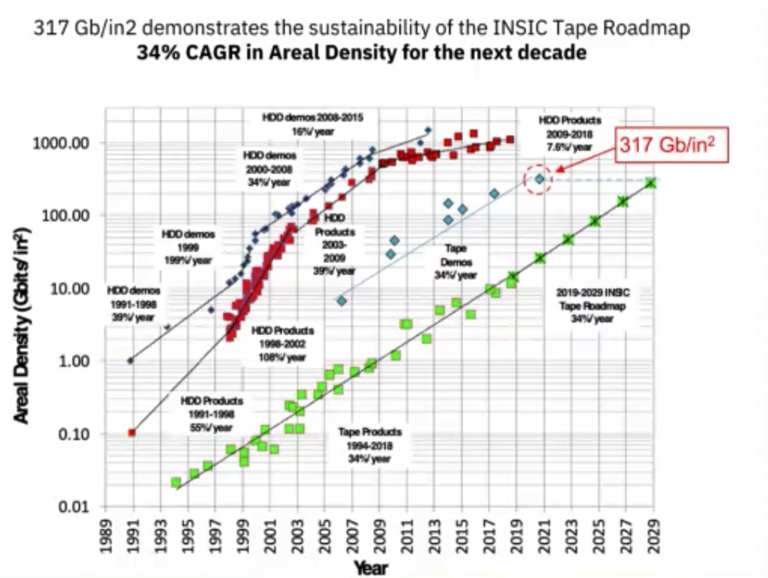580TB Into LTO Cartridge From FujiFilm and IBM, or 32X More Than LTO-9
But when?
By Jean Jacques Maleval | December 23, 2020 at 2:40 pmToday you will find 4 press releases on this web site concerning new technologies to drastically increase the capacity of magnetic tapes, reaching 580TB into a LTO cartridge.
But they miss the most important information: when they will be available? No one gave an answer. And of course no price was revealed.
We will have to wait more than 10 years as the last 12th gen of the LTO roadmap is supposed to be 144TB uncompressed.
This announcement is curious as Fujifilm and IBM already announced the prototype of tape cartridge with uncompressed 220TB in 2015(!) using BaFe synthesis method, with an areal density of 123 billion bits per square inch, 702,000bpi linear density, 181,300tpi, track width of 56.2nm on a tape 4.3μm thick and 1,255m length.
This time FujiFilm is announcing a new technology to deliver 580TB using Strontium Ferrite (SrFe) (replacing sputtered media) with magnetic particles at a record of 317Gb/in2, achieved in running test conducted jointly with IBM Research Europe in Zurich, Switzerland and Tucson, AZ. It corresponds to 48.3x more capacity of current LTO-8.
IBM also developed a new set of technologies to achieve this record, including a new low friction tape head technology that enables the use of very smooth tape media and a detector that enables reliable detection of data written on the SrFe media at this linear density when it is read back with an ultra-narrow 29nm wide TMR read sensor.
Big Blue also developed a family of new servo-mechanical technologies including a new servo pattern that is pre-recorded in the servo tracks, a prototype head actuator and a set of servo controllers, making head positioning possible at a record accuracy of 3.2nm.
When tape is being read, it is streamed over the head at a speed of about 15km/h and, with the new servo technologies, it is possible to position the tape head with an accuracy that is about 1.5x the width of a of DNA molecule.
Even at a 317Gb/in2 recording density, tape is still way behind today’s HDDs on track to hit soon 2Tb/in2 with HAMR.
iNSIC Tape vs. HDD Roadmap from iNSIC

Native 18TB LTO-9 drives are arriving but the current highest capacity unit is the enterprise TS1160 from IBM with 20TB native and delivering a data rate of 400MB/s.
Magnetic tape was invented back in 1928, 92 years ago, but it took years before it got commercialized for audio applications. Historically, the first tape drive for a computer was the UNISERVO from Remington Rand, Inc.’s Eckert-Mauchly Division. One year later IBM launched in May 21, 1952 its first unit, the model 726 Magnetic Tape Reader/Recorder, with an initial capacity of 1.1 per reel, 4 years before its first HDD, the IBM Ramac, at 5MB.
The problem is that the long length of the tape results in average data access time of 50 to 60s compared with just 5 to 10ms for HDDs.
IBM estimates that today more than 345,000EB of data currently reside in tape storage systems.
Capacity shipments of LTO rose to record amounts in 2019 with more than 225 million LTO cartridges, and more than 4.4 million drives shipped since their introduction in 2008 to be compared to around 100 million for HDDs since 1976.
In these press releases, there is nevertheless an information concerning the FujiFilm media as it is revealed that Shin-ichi Ohkoshi, professor, department of chemistry, University of Tokyo, and his team helped to developed a new magnetic material called epsilon iron oxide which, together with a special process to access it, able to offer greater storage densities.
All these press releases affirm that a big advantage of tape is the low price of the media, but not including the expansive drives, explaining that tape is now only used into enormous libraries with a lot of cartridges and few drives.
Note also that there are now only 3 manufacturers involves in LTO, FujiFilm and Sony for the media, and IBM for the drives, limiting the assertions that LTO is really an open technology.
Read also:
Tape Is Not Dead, But Dying
Our analysis
by Jean-Jacques Maleval | 2011.09.05 | News
Tape Not Lowest Priced Storage Technology
As said vendors and some analysts, but not totally dead
by Jean-Jacques Maleval | 2017.01.31 | News











 Subscribe to our free daily newsletter
Subscribe to our free daily newsletter


